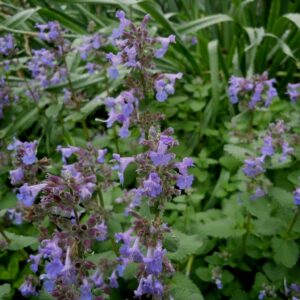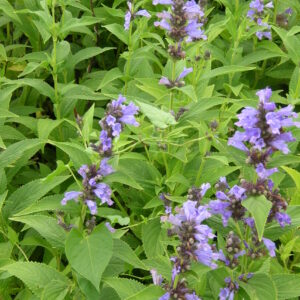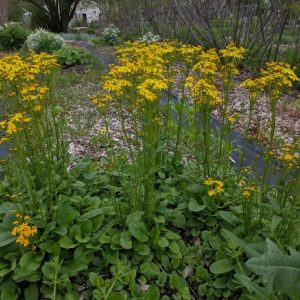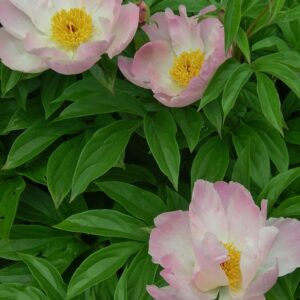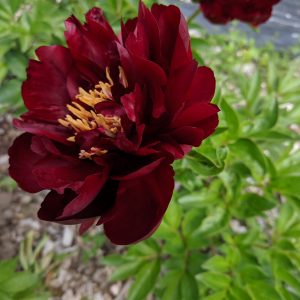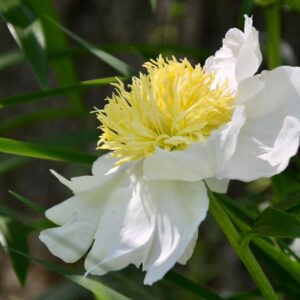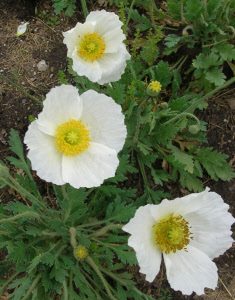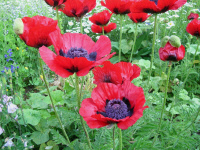Deer Resistant Plants
Showing 97–104 of 155 results
-
Nepeta racemosa syn. N. mussinii Persian Catmint Z 4-8
Lavender blue fragrant flowers from May through September, cut back for rebloom
Lavender blue fragrant flowers from May through September, cut back for rebloom
Size: 18" x 18"
Care: Full sun in well-drained soil
Native: Caucasus
Wildlife Value: attracts butterflies
Awards: Royal Horticultural Society Award of Merit.Nepetas may have been named after Nepete, an old Etrusrian city. Mussinii named for the plant’s discoverer, Russian Count Apollos Apollosovitch Mussin-Pushkin. In gardens before 1810 and a favorite Victorian bedding plant by the late 1800’s. Catmints contain various amounts of an essential oil (nepetalactone) both a cat stimulant and a mosquito repellant.
-
Nepeta subsessilis Japanese catmint Z 4-8
Showy bluish purple spikes of bell-shaped flowers, June-September
Showy bluish purple spikes of bell-shaped flowers, June-September
Size: 18-24” x 18-24”
Care: sun to part shade in moist to moist well-drained soil
Native: Japan
Wildlife Value: deer & rabbit resistant, attracts butterfliesSubsessilis means nearly without stalks. Catmints contain various amounts of an essential oil (nepetalactone) both a cat stimulant and a mosquito repellant. From Nambu Japan where botanists called it Miso-gawa- sô. Von Siebold, German botanist and physician, who worked in Japan from 1823 to1830 saw it. Named in Bull. Acad. Imp. Sci. Saint-Pétersbourg, sér. 3, 20: 469. (1875) by Russian botanist Karl Maximowicz.
-
Packera obovata syn. Senecio obovata Round-leaved ragwort, Golden groundsel Z. 3-8
Clusters of perky yellow daisies with sunny centers atop nearly leafless, erect stems blooming late spring to early summer. After flowering basal foliage makes an attractive groundcover.
Clusters of perky yellow daisies with sunny centers atop nearly leafless, erect stems blooming late spring to early summer. After flowering basal foliage makes an attractive groundcover.
Size: 1-2’ x 6-12”
Care: sun to part shade in moist to moist well-drained soil
Native: curved swath from eastern Canada to FL west to IL and NM
Wildlife Value: attracts bees. Deer resistantObovata means egg-shaped describing the shape of its basal leaves. First named in 1803 from a plant of Rev. Henry Ernest Muhlenberg (1742-1852) Pennsylvania plantsman, sent to German botanist Carl Ludwig Willdenow (1765-1812). Packera named for a Canadian botanist, John C. Packer.
-
Paeonia ‘Seashell’ Sea Shell peony Z 3-8
Blousy, single, ballerina pink petals 6” across, surround golden centers in mid-season, sweetly fragrant.
Blousy, single, ballerina pink petals 6″ across, surround golden centers in mid-season, sweetly fragrant.
Size: 36"x 36"
Care: sun to part sun in moist well-drained soil. Plant “eyes” no deeper than 2” below soil. If planted too low, it will not flower.
Wildlife Value: Deer resistant.
Awards: American Peony Society Gold Medal in 1990.Paeonia is derived from the Greek mythical figure Paeon, who Pluto turned into a flower. Theophrastus described the peony around 300 B.C. Dioscorides, 1st century A.D., claimed the root eased the pain of childbirth. During the Middle Ages peonies used in Europe to remedy the falling sickness, cleaning women after child birth, nightmares, and melancholy. The “surest way” to effect a cure was to hang fresh root around the neck. Otherwise an infusion should be taken before and after a full moon. ‘Seashell’ introduced by H.F. Sass in 1937.
-
Paeonia lactiflora Buckeye Belle Z 3-8
Semi-double, velvety blossoms of the deepest red, almost chocolate, with large outer petals surrounding narrow inner petals sprinkled with sparkling golden staminodes.
OUT OF STOCK
Semi-double, velvety blossoms of the deepest red, almost chocolate, with large outer petals surrounding narrow inner petals sprinkled with sparkling golden staminodes.
Size: 18-24” x 24-30”
Care: Full sun or part shade in most, well-drained soil
Wildlife Value: Deer and Rabbit resistant, attracts butterflies & hummingbirds, great cut flower
Awards: American Peony Society Gold Medal, American Peony Society Award for Landscape MeritHybridized in the USA in 1956 by Walter Mains
-
Paeonia lactiflora x Jan Van Leeuwen Z 3-8
Fragrant cupped single white blooms with yellow stamens
OUT OF STOCK
Fragrant cupped single white blooms with yellow stamens
Size: 2' x 3'
Care: Full sun in moist well-drained soil. Deer and rabbit resistant
Native: Japan
Wildlife Value: birds and ants enjoy the sweet nectar on the buds before openingIntroduced in 1928
-
Papaver anomalum alba Z 5-9
Paper-thin petals on this pure white poppy
Paper-thin petals on this pure white poppy wth yellow stamens blooms all summer and fall – June to October, and November if it’s mild. Absolutely one of our favorites.
Size: 12” x 8”
Care: sun to part shade in moist well-drained to well-drained soil. Deer resistant
Native: European AlpsCollected by 1909.
-
Papaver bracteatum Great scarlet poppy Z 5-8
Glossy fire engine red petals with black heart
Available for purchase in Spring only
Glossy fire engine red petals with black heart in June. D.M. Ferry Catalog, 1876: ”great beauty and magnificent.”
Size: 3-4’ x 3’
Care: sun in well-drained soil. Foliage dies back in summer & reemerges in the cool autumn. Drought tolerant and deer resistant.
Native: Siberia & Northern IranPapaver bracteatum was introduced to European gardens in 1817 from its native Siberia. Poppies have been grown since at least the time when Homer wrote the Illiad, in which he used the poppy’s hanging bud as a metaphor for a dying soldier. During World War I, Canadian soldier John McCrae again united the poppy with dying soldiers. He wrote “In Flanders’ Field.”

